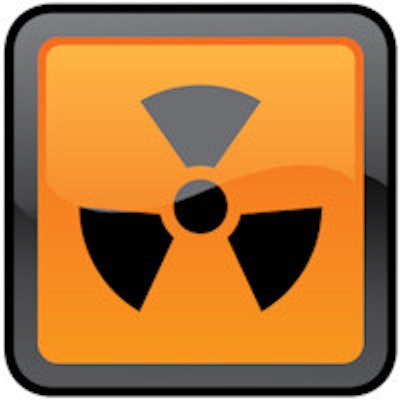
Medical residents have limited knowledge of radiation safety, with just over half knowing that fluoroscopy could produce radiation-induced skin burns, for example. Radiology residents were only marginally more informed, according to survey results published in Academic Radiology.
To their credit, 95% of residents, regardless of specialty, reported a link between ionizing radiation and the future development of cancer, the authors wrote. For radiology residents, 98% said they believe in such a link.
However, only 60% of residents (97% of diagnostic radiology residents) knew that fluoroscopy could result in skin burns. And only 51% of residents (48% of diagnostic radiology residents) correctly estimated that the dose from a single abdominal CT scan is equivalent to approximately 100 chest x-rays. Slightly more than a third of all residents knew that children are about five times more radiosensitive than adults (Academic Radiology, April 7, 2014).
"We need more education both for radiologists and nonradiologists, but probably radiology residents need to know it better," Dr. Gelareh Sadigh from Emory University told AuntMinnie.com. Sadigh's co-authors on the paper included Dr. Kimberly Applegate and others from Emory and Children's Hospital in Atlanta.
Controversial relationship
The relationship between radiation dose and cancer risk remains controversial, but the general consensus in the scientific community is that there is no safe radiation dose. There is growing concern that low-dose ionizing radiation may be associated with increased cancer risk depending on the dose and duration of exposure, especially in young patients, the authors wrote.
The goal of the survey was to assess the frequency of discussion about radiation safety in residency programs, test residents' knowledge about radiation safety, and determine attitudes about radiation-monitoring badges and protective clothing. Data were gathered through SurveyMonkey and analyzed using Stata 10.
The researchers chose to survey medical specialties most likely to encounter radiation, including family and internal medicine, emergency medicine, surgery, obstetrics and gynecology, and radiology (including diagnostic radiology, radiation oncology, and nuclear medicine).
They compared responses by medical specialty, gender, and year of residency. Estimates were given variable weighting depending on their similarity to the correct answer, and chi-squared tests for categorical variables were used to determine significant differences between groups.
Approximately one-third (32.5%, 173/532) of the residents invited to respond completed the survey, and of these, 39% said radiation safety was discussed in their curriculum at least twice a year.
"Radiology residents -- particularly diagnostic radiology residents -- showed moderately higher knowledge than their clinical resident colleagues when estimating radiation dose and deterministic and stochastic risks from radiation exposure," Sadigh and colleagues wrote. But the differences weren't impressive.
"We were expecting residents, especially those working in heavy fluoro units, to have more knowledge about radiation," Sadigh said.
Overall, 95% said they believe there is a link between radiation exposure and cancer development; however, residents' knowledge about specific dose effects was limited.
| Radiation survey responses | ||
| Question | Radiology* (% correct) | All specialties (% correct) |
| Risk of lifetime fatal cancer is 20% in the U.S. population | 40% | 25% |
| Children are 5 times more radiosensitive than adults | 50% | 35% |
| Ionizing radiation > 200 mGy is associated with fetal brain malformation | 26% | 10% |
| There is a risk of developing cancer in patients or interventional personnel who are frequently exposed to ionizing radiation, but it is uncommon | 79% | 70% |
| Risk of lifetime fetal cancer from abdominal CT (performed based on adult protocol) is 1:1,500 | 29% | 22% |
| Radiation dose from abdominal CT scan is equivalent to 100 chest x-rays | 51% | 48% |
Sadigh and colleagues were surprised by the low levels of radiation knowledge among the residents.
"Only 27% knew that people involved in radiology interventional work are at five times the risk of developing cataracts," he said. "We were expecting that residents who were working with fluoroscopy, like surgeons and especially vascular surgery, would know more."
And most residents were way off the mark in guessing the approximate dose of an abdominal CT scan.
"It can vary a lot, but we also gave a very wide range, and less than 50% chose a range anywhere close to what it might be, even radiology residents, which is very disappointing" Sadigh said.
Underestimating the dose and the potential harms of a test could lead to inappropriate imaging, the authors noted.
Interestingly, there was no significant difference in residents' knowledge about radiation safety across their postgraduate training years, the group found. Perhaps owing to the early introduction of physics and radiation biology, radiology residents were generally more comfortable discussing radiation safety in imaging.
Eight-six percent of all residents (97% radiology, 80% nonradiology) reported using lead shields. Thirty-nine percent (68% radiology, 15% nonradiology) said they used radiation-monitoring badges.
Limitations of the study included its single-center design, and the response rate was so low for some specialties that the responses were probably not representative, the authors wrote. There was no representation of pediatric residents, who perhaps have greater knowledge of safety issues.
Today's residents will eventually make imaging use decisions that affect patient care, and currently there seem to be gaps in their knowledge, the authors wrote. But these can be addressed through a number of interventions, including more interaction with radiology faculty all the way from medical school through residency and fellowship.
"Part of it can be just the basics of radiation safety -- maybe involving medical physicists in the process -- starting when they are still medical students and continuing throughout their medical education," Sadigh told AuntMinnie.com. "In their first years, residents hear a long talk about this stuff, but then it's gone until the boards come."
The use of required credentialing programs in fluoroscopy and the implementation of electronic clinical decision-support systems would also be helpful, the authors wrote.



















